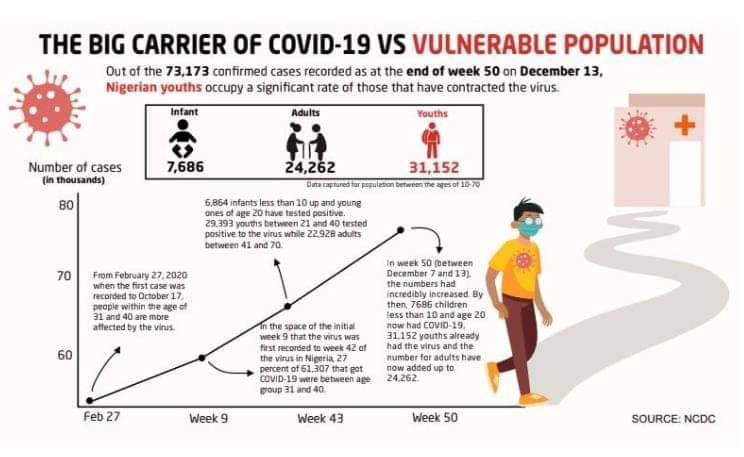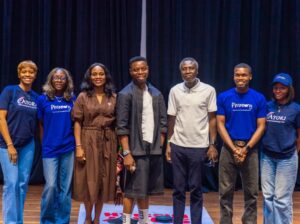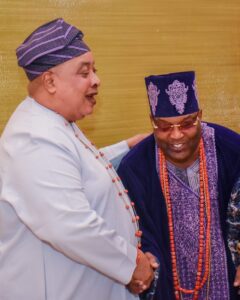
Nigerian youths are the big carriers of COVID-19 but the old are dying more
COVID-19 statistics show that youths are the big carriers of the virus in Nigeria, but the elderly are the ones being killed by it, writes GABRIEL OGUNJOBI
Abiodun Kolawole, a student of Moshood Abiola Polytechnic (MAPOLY) is perhaps one of the rarest residents of Abeokuta, Ogun State who is yet to be gripped by the fear of the novel COVID-19 up to date. He would need more than the constant, untethered the rise in the number of COVID-19 cases in Nigeria as released by Nigeria Centre for Disease Control, NCDC to believe the realness of the killer virus let alone admit Nigeria has transited into the second wave may soon hit.
“I have not seen anyone who had that virus around me nor has anyone died of it – God forbid! – except the ones the government tells us.”
In contribution to that doubt, his friend, Damilare Obatola, both seated inside a POS outlet (for money transaction) at Computer Village of Oke Elewo, the commercial nerve of Ogun State capital, made a more befuddling comment.
‘You may want to talk about the death of Kashamu… I don’t believe he died of covid. I have seen him before and I know the disease wouldn’t have killed him’, he said.
Contrary to Damilare’s perception, former Senator Buruji Kashamu representing Ogun-East senatorial district, died on August 8 of COVID-19 complications at the First Cardiology Hospital in Lagos.
His death was announced by his former colleague in the Senate Ben Murray-Bruce.
Already, 33 people had died of the virus in Ogun state as at the dusk of December 6, what the state’s Director of Public Health and Incident Manager, Dr. Festus Soyinka, described as ‘mild effects of the virus in Ogun state.’
Added to this figure, a total of 35 people tested positive to Coronavirus across the state by the close of business on December 6 that these young Nigerians doubted the existence of the virus. The 35 people are the cumulative cases out of the 2,258 confirmed cases by the end of the 49th week.
At the end of week 50 between December 7 and December 12, this newspaper found out that the cases in Ogun State had risen to 2328.
The NCDC corroborated in its week 50 spreadsheet report for the COVID-19 cases that Nigeria has experienced a significant increase up to 47 per cent in the number of confirmed COVID-19 cases compared to week 49. Nigeria had a total of 61,992 at the end of week 49 but skyrocketed to 66,090 at the end of week 50.
As if this never mattered to the residents, no single person at the computer village had face masks worn. Yet, all was, in fact, raucous, and bubbling up till Lafenwa market some few kilometres ahead with no attention to public health measures.
Between half-knowledge and ignorance
The manager of the small-scale business, Adewale Kolajo, cautioned that his boys’ disbelief should not be blamed on ignorance. According to him, their doubt found its strength in distrust in the Nigerian government over the ill-management of the virus from inception.
‘I am educated and I have read about the workings of this virus. So, I know it is real’, he would stress.
As convincing as his response was at the first presentation, the impression he later gave drew a line between the extent of his knowledge about the pandemic and unchecked myth.
‘However, the only reason the countries here are not recording massive numbers is because of our relatively hot temperature. Even before or without treatment, coronavirus will not survive above 30’, he said confidently.
That belief is one of the fast-travelling rumours which the World Health Organization, WHO had demystified.
Often said that ‘coronavirus is not heat-resistant and will be killed in a temperature of 26-27 degrees’, WHO established that evidence has so far shown that COVID-19 virus can be transmitted in all areas, including areas with hot and humid weather.
In MAPOLY, Cinema, the culture is gone; remnant left is protocol’
This reporter headed to Adeola’s school to establish if he was only one of the few who take prevention with levity.
Mapoly, like most public institutions, adhered to the guidelines upon reopening of activities. In front of the mechanical engineering department – near the polytechnic’s entrance gate – a hand-washing basin and soaps can be visibly seen but people only stroll past, defeating the purpose of placing it there. Several corners within the campus including the Administrative structures with the Rector’s office, non-academic staff offices, stickers and banners informing about the importance of face masks are in the public glare.
But, the zeal towards enforcement of these guidelines has dwindled.
On Tuesday, December 8, which was the second day of the resumption for the second semester of an academic session, the students shook hands, hugged each other, and also troop into public transports without minding the possibility of the virus spreading.
“Am I doing anything wrong here? It seems I am the only one wearing face masks”, this reporter said, intentionally starting a conversation inside a bus full-loaded of passengers.
It was the driver who first answered.
“We all know it’s just the protocol that remains.”
One of two young women, who later alighted at the market junction within the campus, joined to say: “I also have mine in the bag. I still use it when I know I should”, as if being inside a fully-loaded bus isn’t one of those times.
A similar attitude had been observed at the cinemas inside Nigeria’s former president, Olusegun Obasanjo Presidential Library, OOPL, in Abeokuta, on Saturday evening. At the entrance of the cinema, a lady attendant would allow customers to donning your masks as they reconfirmed people’s temperature but upon entry, removal of the mask was “official” to many.
On that particular night which the screening movie at 9 pm was ‘Citation’, even the attendant was visibly not wearing the mask.
No Regards for COVID-19 protocols at Ibadan football centre
Honorable Akin Alabi, representing Oyo state’s Egbeda/Ona Ara at the House of Representatives is a football enthusiast. One of his excitements – and his political magic wand at getting intimate with his constituents – is to relish both local matches and foreign matches with the youth.
On June 20, he tweeted how intense he had missed doing so in spite of COVID-19 lockdown on social gathering. Assuming the lawmaker chose to return to do so anytime from now, he may not escape contracting the virus except he took extra precautions.
As Arsenal, one of North London’s giant football teams, slugged it out with Tottenham Hotspur on Sunday, December 6, this newspaper was at the lawmaker’s favourite viewing centres in Ibadan to observe the level of compliance in a place largely dominated by youths.
At the centre at stone-throw from Alabi’s family house in a Bokusoro Street of Gbagi, none of the viewers had masks with them, save one who had it just below the jaw. The immensely-full room also gave no consideration for the two-metre social distancing nor made provision for hand washing.
So, for every goal attempt made by Tottenham against the soon-to-be relegated Arsenal, the prolonged shouts and chit-chats among viewers made the spread of COVID-19 seamless, if one of them had been an asymptomatic carrier.
A peek into data revealed low testing capacity in Oyo state compared to its massive population. Up till week 50, the state had only tested 28,638 people and 3,760 were confirmed positive. 45 people have been recorded dead.
Public health laboratories are said to have increased from 5 to 80 across the 36 states and FCT.
Scary spike in Lagos – even the governor is not spared
On December 12, Lagos State Governor Babajide Sanwo-Olu was announced to have contracted COVID-19.
His infection was the latest among a number of Nigerian governors that have tested positive in the past, despite heading the epicentre of the virus in Nigeria.
COVID-19, goes on night workout)
Before Sanwo-Olu’s infection, social gatherings like markets, carnivals, clubs had been reopened. In the bustling city, many public means of transport have also reverted to the old times of full-load passengers and fewer people now wear their face masks.
The confirmed cases have surged to 24,952 from inception at week 9 to the end of week 50 on December 12. The active cases were 1282 while 231 people had died as of then.
The big carrier of COVID-19 vs vulnerable population
Out of the 73,173 cases recorded as of December 13, the end of the 50th week, Nigerian youths account for a significant rate of those cases.
According to data from the public health agency, between February 27, when the country recorded her index case and October 17, people between the age of 31 and 40 are more affected by the virus.
At that time, 27 percent of 61,307 that got COVID-19 were between the age group 31 and 40. Others were spatially distributed across the remaining seven categories but the commission didn’t give the actual figures for each of the eight categories.
However, from week 43, when NCDC began to publish the breakdown for the age groups, findings revealed that youths (between 21 and 40) tested positive more than other age groups.
As of week 43, 6,864 infants less than 10 up and young ones of age 20 have tested positive. 29,393 youths between 21 and 40 tested positive to the virus while 22,928 adults between 41 and 70.
By week 50 (between December 7 and 13), the numbers had greatly soared as 7686 children and teenagers, 31,152 youths and 24,262 adults had contracted the virus.
….but data says the old are dying more
As of week 43 (between October 19 and 24), 28 children below age 21 had died of COVID-19 in Nigeria, 158 youths between ages 21 and 40 had also died while 942 people between 40 and 70 had died by that same time, making it a total of 1128 for the eight categories mapped out by NCDC.
In the space of that week and week 50, (between December 7 and December 13), the death rate for children below 21 had only increased by two from 28 to 30. For youths between ages 21 and 40, it only increased by two persons too from 158 to 160 but it snowballed for adults between ages 40 and 70. 973 people between ages 40 and 70 had died by December 13, making a total of 1166 for the eight categories given by NCDC.
In summary, 30 children below age 21 had died of COVID-19 as at the end of December 13, 160 youths between ages 21 and 40 and 973 adults between ages 40 and 70.
Data corroborated the fact that although the youths test more to the virus, they quickly recover in spite of a strong immune system but the adults are more vulnerable to the grip of the killer virus.
This investigation also abundantly established that the youths rove and interact in public places more where the chances of infections are high.
Authorities, epidemiologists warn youths about rising figures
In an exclusive response sent to this reporter via email, the NCDC Director-General, Dr. Chikwe Ihekweazu confirmed findings that the country has indeed recorded a surge in the confirmed cases among the youth especially between ages 21 and 30 in the last few weeks, attributing the reason to increased social gathering and poor adherence to public health measures.
He, however, admonished Nigerians to be more cautious of their activities and minimise travels.
‘While chances are higher that young people recover from COVID-19, they can transmit the disease to their parents and elderly, who are at risk of dying. We continue to appeal to young people across the country and every Nigerian to remain aware of the risks of the disease and especially its impact on the elderly.
‘Please avoid all gatherings especially when held indoors, avoid non-essential travel, remain in isolation if you suspect you have COVID-19 and get a test. The virus is still with us and we must take responsibility to avoid large gatherings, wash our hands regularly, maintain physical distancing of at least two metres when in public and importantly, wear a mask to cover your nose and mouth.’
To survive the acute second wave of the pandemic, the Director-General also assured that the PTF on COVID-19 and NCDC will scale up risk communications within the societies.
“We have continued to scale up our risk communications by providing advisories, guidelines, and other materials to various aspects of society.
“We will continue improving the work we do, but our success is really dependent on collective responsibility by all Nigerians. The virus is still with us so we cannot go back to business as usual.
“It is important to note that not every measure requires the government’s efforts alone. Several institutions have a role to play in ensuring adherence to preventive measures- business owners, religious leaders, traditional rulers, school heads among others’ he noted.
Experts have attributed reasons for high infection of youths to socio-economic factors like large population in the country and employment as well as their availability to testing.
“Everyone can be infected by the virus but the common reason for the prevalence among the Nigerian youth is because they are the ones who are testing more in spite of their large population’, said the Ogun state epidemiologist, Dr. Hakeem Yusuf.
“By the way, our old people easily mistake the COVID-19 symptoms for malaria and unfortunately end up dying before reporting for the test.’
Similarly, the state’s Director of Public Health and Incident Manager, Dr. Festus Soyinka established that the youths are the dominant working-class, hence their vulnerability.
But, he raised concerns over the level of enforcement to COVID-19 guidelines by the Nigerian securities who should ordinarily be responsible for that.
“It is not our work at the ministry of health to enforce compliance in public transport and public gatherings.
“Now that the President has ordered the reopening of some land borders including that of Ogun State close Benin Republic, we are calling on securities to ensure travellers comply while going about their businesses in and outside the state.”
Lagos Ministry of Health PRO Mr. Tunbosun Ogunbanwo advised the journalist to wait for the commissioner’s briefing or that of the governor as regards the recent development “in a matter of a few days”.
On the evening of Friday, December 18, Governor Sanwo-Olu returned restrictions on worship centres, banning concerts, carnivals, and nightclubs.
“The protocol of ‘No Mask No Entry’ must be enforced by all public places: offices, businesses, markets, shops, and so on.
“All places of worship (Churches, Mosques, etc.) must ensure that no gathering exceeds two hours, and also that no gathering exceeds 50% of the maximum capacity of the venue.
“A minimum of two meters’ distance should be maintained between seated or standing guests. “All guests and service providers at events must wear nose masks/coverings before entry”, he further warned.
⦁ This report was facilitated by the Wole Soyinka Centre for Investigative Journalism (WSCIJ) under its COVID-19 Reality Check project.












